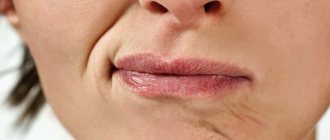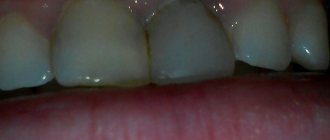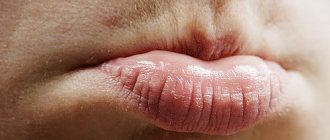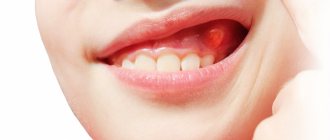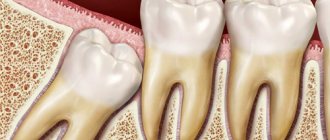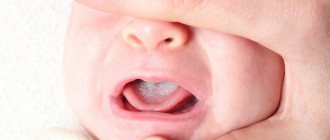Swelling of the upper lip in a child indicates the development of pathological processes in the body that require mandatory treatment.
This article discusses the main causes, symptoms and treatment methods depending on the etiology of edema. Possible complications and prevention of this condition in a child are also described.
Why is my child's upper lip swollen?
A swelling on a child’s lip cannot occur on its own. This signals the emergence of some problems that affect the baby’s health.
To prevent them, it is important to correctly and timely identify the factors that provoked swelling.
Among them, experts highlight:
- It is important to correctly and timely identify the factors that provoked swelling
Allergy, as a reaction to certain foods , oral hygiene products. This is also how the body can react to taking certain medications or the presence of orthodontic structures in the mouth.
- Insect bites provoke swelling of the mucous membranes of the lips, as a result of individual allergies.
- Teething may be accompanied by slight swelling of the baby's lips.
- Traumatic injury. In addition to mechanical damage, a swollen lip in a child can cause frostbite, chapping, or burns.
- Pathologies of systemic viral, infectious or bacterial origin. Most often, the body reacts this way to ARVI, herpes infection, or acute respiratory infections.
- Dental diseases: periodontal disease, stomatitis of any etiology, periodontal disease, periostitis.
- Dentist mistakes. Incorrect treatment or poor quality dental procedures can cause lip swelling.
- Inflammation. This symptom is characteristic of many diseases, or may be a response to a lip injury.
Important! If the swelling of the lip is caused by an inflammatory process, then the presence of accompanying symptoms is mandatory. This may include hyperthermia, soreness and a change in color. Also, depending on the etiology, ulcers may appear on them. - The habit of biting your lip provokes constant mechanical damage, which becomes the main cause of the formation of microcracks and wounds with subsequent infection.
- Hygiene problems. Children begin to learn about the world through their mouths, so it is impossible to maintain proper hygiene of the oral cavity and all objects that the baby puts into his mouth. The entry of bacteria into the mouth provokes the development of inflammatory processes, which can cause the lip to swell.
Other causes of upper lip swelling in children
In addition to dental diseases, there are a number of other diseases and conditions that lead to the pathology in question:
- allergic reaction to an irritant (animal fur, certain foods, toothpaste);
- mechanical damage to the lip (impact, biting);
- furunculosis (first a tumor forms, and only after 1–2 days it will be possible to visually determine the location of the formation of a purulent focus).
Non-pathological causes include teething at an early age (the child simply injures the delicate mucous membrane on the inside of the lip with sharp edges), and an insect (mosquito) bite.
Symptoms
In medical practice, swelling on the lips can be localized in any area. Most often in children, its upper part swells. But, regardless of where the swelling is located, this condition can be a sign of a life-threatening condition.
The appearance of swelling on the upper lip, depending on the etiology, may be accompanied by the following symptoms:
- Regardless of where the swelling is located, these symptoms may be a sign of a life-threatening condition.
The anatomical shape of the lips changes.
- Rapid and sudden development of a tumor.
- The appearance of swelling of the mucous membranes of the tongue and oral cavity.
- There is an unpleasant odor from the mouth.
- Increased pain on palpation of the lip and area under the nose.
- Labored breathing.
- Itching sensation on the lips, throat or mouth.
- The skin began to darken and acquire a blue tint.
- High body temperature, chills, fever.
- Sensation of a foreign object in the throat.
- There may be small pimples and blisters on the lips.
Important! If a child shows the slightest sign of swelling on the upper lip, it is necessary to immediately seek qualified medical help. The specialist will be able to correctly determine the cause of swelling and prescribe appropriate treatment to stabilize the child’s condition.
Associated symptoms and what do they indicate?
In addition to the main symptoms, swelling of the lips in a child is always accompanied by additional symptoms.
According to the accompanying manifestations, the diagnosis is made easier:
| Sign | What does it indicate? |
| Temperature | The development of both general and local hyperthermia indicates an infectious etiology of the disease and the appearance of inflammation. |
| Only the middle of the lip is swollen | The formation of an abscess as a result of mechanical trauma to the soft tissues and pulp of the tooth. |
| My lip is very swollen | For the occurrence of an allergic reaction in the form of Quincke's edema, disruption of the functionality of the salivary glands, or severe injury and insect bites. |
| Swollen lower lip | For the appearance of neoplasms of various etiologies, the development of angioedema or allergic edema. And also for mechanical injury to the integrity of the lip. |
| The lip is festering | This sign is a symptom of bacterial infection of the oral cavity, the development of purulent stomatitis, cheilitis, type 1 herpes, or the presence of closed acne. |
Important! Regardless of the visual signs, to make an accurate diagnosis it is necessary to undergo a full examination, which includes laboratory testing.
Symptoms of gingivitis in babies
The course of the disease in children is most often observed in an acute form, which is easy to determine:
- When brushing your teeth, a lot of blood remains on the brush;
- soft tissues become bluish due to damage due to bacterial infection;
- painful sensations occur when biting food or drinking drinks;
- swelling, redness and discharge of serous contents.
If you have one or more symptoms, you should contact your dentist immediately. Only professional and high-quality treatment provided on time can prevent chronic inflammatory processes in the oral cavity.
In its extreme form, destruction of tooth enamel and damage to teeth by caries is possible, and, as a result, further complex therapy, up to extraction and prosthetics. Seeing a doctor as quickly as possible at the first symptoms of inflammation will help avoid complications.
Remember that mild gum disease responds quickly to treatment.
Diagnostics
To make an accurate diagnosis and identify the causes of the disease in case of swelling of the upper lip in a child, it is necessary to undergo a timely medical examination.
If rapid swelling occurs, you must urgently call an ambulance or consult an allergist yourself. This condition is dangerous because swelling of the throat can develop, which can result in asphyxia, which can be fatal.
If swelling appears gradually and is accompanied by additional sensations, to eliminate them, you may need the help of doctors such as:
- An examination by any doctor begins with a visual examination.
Dentist.
- Pediatrician.
- Infectious disease specialist.
- Maxillofacial surgeon.
- Otolaryngologist.
- Oncologist.
An examination by any doctor begins with a visual examination. Then, taking into account the clinical picture, specialists prescribe a series of examinations.
Among them it is worth highlighting:
- Laboratory tests: clinical blood test, flora smear, general blood test, biopsy, biochemical blood test.
- Hardware examination: radiography, ultrasound, MRI or computed tomography.
Important! Timely and complete diagnosis of the pathology will allow you to choose the right treatment. This will significantly reduce the child’s recovery time.
Diagnosis and treatment of gingivitis in young children
Gingivitis in children is diagnosed during a standard dental examination. If a visual examination is not enough to make a diagnosis, the doctor may order an x-ray.
Treatment of gingivitis in children under one year of age
and older requires an integrated approach. The course of prescriptions is selected individually, taking into account the form of the disease and the age of the small patient.
Complex treatment of gingivitis in children under 2
years and older:
1. Removing soft microbial plaque and hard dental deposits from the surface of teeth.
2. Polishing tooth enamel with special brushes.
3. Antiseptic mouth rinses.
4. The use of anti-inflammatory gels and ointments to treat inflamed gums.
5. Sanitation of the oral cavity. When gingivitis is diagnosed,
treatment in children 3 years of age
and younger is based on gentle techniques. For example, to remove carious formations, teeth are silvered without drilling.
In severe forms of gingivitis with a high risk of complications, antibacterial agents are included in drug therapy. The drug and dosage are selected by the attending dentist.
When diagnosed with gingivitis, treatment in children (4 years
and younger) with the use of antiseptic solutions for rinsing the oral cavity is successfully replaced by applications using cotton swabs soaked in a medicinal composition. This recommendation is relevant if the baby refuses or cannot independently perform the mouth rinsing procedure.
What to do if your lip is swollen - treatment, depending on the cause
If there is swelling on the lip, the therapeutic complex is selected taking into account the main factors that provoked this condition in the baby.
The doctor also takes into account the child’s age and his individual physiological characteristics of the body and health in general.
What to do if your lip is swollen:
- The doctor takes into account the child’s age and his individual physiological characteristics of the body and health in general.
Herpes virus , in which the mucous membranes are covered with small ulcers and blisters: treatment with peroxide, furatsilin solution, levomikol ointment.
- An allergic reaction is treated with general and local antihistamines.
- Tramming. The damaged area is treated with a disinfectant. Afterwards, the use of wound-healing ointments, essential oils, and propolis is allowed.
- Dental pathologies and errors are treated exclusively by specialists in a specialized clinic.
Important! In most cases, as a universal aid, if a child’s lip is swollen, doctors recommend rinsing the mouth with antisemitic drugs and herbal decoctions.
How to relieve swelling?
When treating swelling of the upper lip in a child, medical practice uses drugs and traditional medicine that have decongestant, anti-inflammatory, antiseptic, antihistamine, and analgesic effects.
Among pharmacological drugs, particular effectiveness is observed in complex treatment, consisting of oral and local medications:
- Self-prescription and incorrect dosage can not only aggravate the development of edema, but also reduce the overall health of the baby
General drug therapy, depending on the etiology of the cause of swelling , consists of using tablet drugs: Suprastin, Ibuprofen, Rimantadine, Anaferon, Gerpivir.
- Local therapy has a symptomatic effect and stimulates tissue regeneration. Most often in pediatrics, when a child has swollen lips, the following are prescribed: Stomatidin, oxalic ointment, Acyclovir, brilliant green solution, Lamisil, hydrogen peroxide.
- Natural medicines recommended by naturopaths are prepared based on herbal ingredients. Most often in this case they use: aloe juice and pulp, decoctions of medicinal herbs, herbal infusions, beekeeping products, Fuller's earth, baking soda. In addition to the local use of folk remedies, children are recommended to drink herbal teas to strengthen general immunity.
Important! The prescription of medicines and folk remedies should be carried out exclusively by a pediatrician based on the results of the examination. Self-prescription and incorrect dosage can not only aggravate the development of edema, but also reduce the level of overall health of the baby.
Treatment of gingivitis in children in the dental clinic
If your child exhibits characteristic signs of gingivitis, make an appointment for your child at the specialized dental clinic “Aesthetics”. High-level children's specialists with extensive professional experience work here.
The center is equipped with modern equipment that allows high-precision diagnostics and painless treatment of any diseases of the teeth and gums. When treating gingivitis in children and adults, qualified dentists use only high-quality medications from reliable global suppliers.
The center has a flexible pricing policy. All patients who leave their reviews on the Aesthetics website are guaranteed a 3% discount on all dental services.
Possible complications
Most often, a swollen upper lip in a child, with timely and correct medical care, does not pose a danger to the health, much less the life of the child. In most cases, swelling goes away and leaves no negative consequences.
But it is worth noting that neglecting the baby’s condition or not following medical prescriptions can provoke the development of the following negative consequences:
- In most cases, swelling goes away and leaves no negative consequences.
Having a large scar.
- Eczema in an advanced stage.
- Development of sepsis.
- Life-threatening infection.
- The spread of herpes rash not only over the entire lip area, but also on the face.
- Rapid development of Quincke's edema during an allergic reaction.
- The appearance of a malignant neoplasm.
Important! To prevent the development of complications, treatment of lip swelling in a child must begin at an early stage.
A child has a lump on his gum - causes and treatment
This section is very important because... will show how untimely dental treatment, parents ignoring changes in the color of baby teeth or their superficial destruction - leads to the rapid development of periodontitis of the baby tooth, against the background of which a purulent abscess forms on the gum. Usually parents believe that they cannot do anything about it, because... The child still won’t let his teeth be treated. But modern dentistry allows even infants to have their teeth treated under sedation, allowing them to sanitize all their teeth in one visit without fear.
Reasons for the appearance of an abscess/bump on the gum –
- Untreated caries of one of the teeth is the main reason for the appearance of such ulcers. Caries in children occurs against the background of irregular hygiene and constant snacking between main meals. Caries sooner or later turns into pulpitis (at this stage, infection from the carious cavity penetrates into the tooth pulp, causing inflammation in it). Inflammation of the pulp leads to the gradual death of the neurovascular bundle inside the tooth - as a result of which a focus of purulent inflammation develops at the apex of the tooth root (apical periodontitis).
- Poorly treated teeth - in public dental clinics, usually no one will bother with your child, persuading him to be patient while the doctor carefully drills out the carious tissue and puts a filling.
Usually, the maximum that dentists offer to children under 3-5 years of age is the method of silvering teeth. But this method only slows down the development of caries and is not a complete treatment method. In addition, silvering of the same tooth must be carried out repeatedly (after a certain time). As a result, in most teeth treated with the silvering method, first pulpitis (inflammation of the nerve in the tooth) always develops, and then periodontitis.
- Traumatic damage to a tooth is the second most common reason why a lump appears on a child’s gum.
A strong mechanical impact on the tooth (fall, bruise, blow) can lead to the death of the nerve in the tooth, and even to a fracture of the crown or root of the tooth. Dental injuries do not always lead to these consequences; for example, if the blow was not very strong, then everything may well end well. If an abscess has nevertheless formed, and there is no caries or filling on the tooth (in the projection of the abscess), then the obvious reason for the development of purulent inflammation will be mechanical trauma to the tooth. This reason will also be supported if you find mobility of the tooth crown in the projection of the abscess that has formed, or a change in the color of the crown to bluish or gray.
How does a purulent abscess form further?
The formation of a purulent abscess on the gum of a child occurs as follows... In general, periodontitis of the tooth for a long time in a child can be asymptomatic, but with hypothermia or decreased immunity, chronic inflammation at the apex of the root worsens - with the formation of pus at the site of inflammation. The pus tends to come out and therefore it gradually “makes” its way through the bone tissue, first falling under the periosteum of the jaw, where a subperiosteal abscess is formed.
Let us recall that the surface of the jaw bone tissue is covered with periosteum, and only on top of the periosteum is the mucous membrane located. When a purulent abscess is located between the surface of the bone and the periosteum, dentists call such inflammation the term “periostitis.” With periostitis, there will be a characteristic swelling on the gum that is dense to the touch, touching which will be very painful (but there will not yet be a clearly contoured lump with pus).
Next, purulent melting of the periosteum may occur, and then pus enters the submucosal membrane, forming a so-called “submucosal abscess.” The mucous membrane has high elasticity, and therefore a “bump”, soft to the touch, with clear contours, filled with pus (usually painless when touched) is formed on the gum. It should also be noted that in parallel with inflammation of the gums, swelling of the soft tissues of the face, as well as lymphadenitis of the submandibular lymph nodes, can also be observed.
Preventive measures
You can easily prevent the development of puffiness on your lips.
To do this, the following preventive measures must be observed:
- Consume exclusively clean foods.
- Keep your hands and mouth clean.
- Drink vitamin complexes systematically.
- During seasonal exacerbations, take antiviral drugs.
- Avoid trampling.
- Have regular dental checkups.
- Treat dental pathologies in a timely manner only from trusted specialists.
- For allergy sufferers, avoid contact with allergens and always carry antihistamines with you.
- Avoid psycho-emotional stress.
- Minimize stressful conditions.
Important! The main thing in preventing swelling of the upper lip in a child is its regularity. Only with this approach is it possible to avoid the appearance or recurrence of this condition.
Swelling of the lip in a child is not always an independent disease. In most cases, this is a clear sign of more serious pathologies. Therefore, if even the slightest swelling occurs, you must immediately consult a doctor.
Abscess on the gum of a child: treatment
Thus, if a lump or fistula appears on a child’s gum, you should immediately go to the dentist. The treatment strategy will depend on whether the tooth is baby or permanent. You can determine this yourself using tables with the timing of the eruption of baby and permanent teeth.
- If the causative tooth is still baby – unfortunately, milk teeth, which have caused the appearance of ulcers on the gums, must be removed. Such teeth cannot be treated, because... The roots of baby teeth are not formed; they have wide root canals that simply cannot be filled in the same way as is done with root canals in permanent teeth.
You can read about this in any textbook on pediatric dentistry. Unfortunately, in recent years, due to the deterioration in the quality of training of doctors, you can hear that many pediatric dentists recommend not removing such teeth, citing the fact that removal will cause malocclusion. This is partly true (but primarily only in relation to primary molars, the removal of which can lead to a shift in the rudiments of permanent teeth).But this is not the only thing to consider. The purulent focus of inflammation in the area of the roots of a baby tooth is separated from the permanent tooth germ by only 1-2 mm of bone (Fig. 6). Studies have shown that disruption of the eruption of permanent teeth is caused not only by the early removal of baby teeth, but also by the influence of pyogenic bacteria and their toxins on the rudiments of permanent teeth. In some cases, they even cause the death of a permanent tooth germ.
It is also necessary to take into account the effect of a pyogenic infection on the general health of the child. For example, the fact that infection from the source of inflammation will constantly enter the submandibular lymph nodes, causing the development of lymphadenitis. In addition, once in the blood, waste products of pyogenic bacteria affect the entire body as a whole: they increase the risk of developing allergies, bronchial asthma, diabetes, heart and joint diseases.
If purulent inflammation is accompanied by the formation of a fistula, then you must understand that pus will constantly enter the oral cavity through the fistula, the child will swallow it, this will lead to the colonization of the tonsils with a pyogenic infection and the development of chronic tonsillitis. In general, constant colds are guaranteed in this case.
- If the causative tooth is permanent , in this case the tooth is not only possible, but also necessary to be saved. Treatment of permanent teeth with periodontitis in children is carried out in the same way as in adults, i.e. The nerve is removed and the root canals are filled. The first permanent teeth erupt by the age of 6, which allows children of this age to undergo normal treatment (under good anesthesia).
Important:
You cannot self-medicate!
No amount of rinsing, application, herbs or even the strongest antibiotics will cope with the source of inflammation at the apex of the root, and this can only give a short-term effect. It is also pointless to wait for everything to “resolve” on its own. Even if the lump bursts or the fistula closes, all this only indicates a temporary subsidence of the process, but at this time the infection and toxins will still be absorbed into the blood and lymph, affecting the functioning of all organs and tissues. Such chronic foci of purulent inflammation are especially dangerous if the child already has concomitant diseases (heart, respiratory organs, joints, etc.). But if there are no such diseases, then the presence of a chronic purulent focus of inflammation increases the risk of many somatic diseases.
How to prevent ulcers on the gums - first of all, only proper oral hygiene of the child, as well as proper nutrition, can help with this. To learn about the age at which you should brush your teeth and how to do it correctly, read our article: → “Current issues of oral hygiene in children”
It is important to use additional methods of protection against caries, such as remineralizing therapy, treating teeth with fluoride varnish, and for erupted permanent teeth, also a method of sealing fissures on the chewing surface of the teeth.
